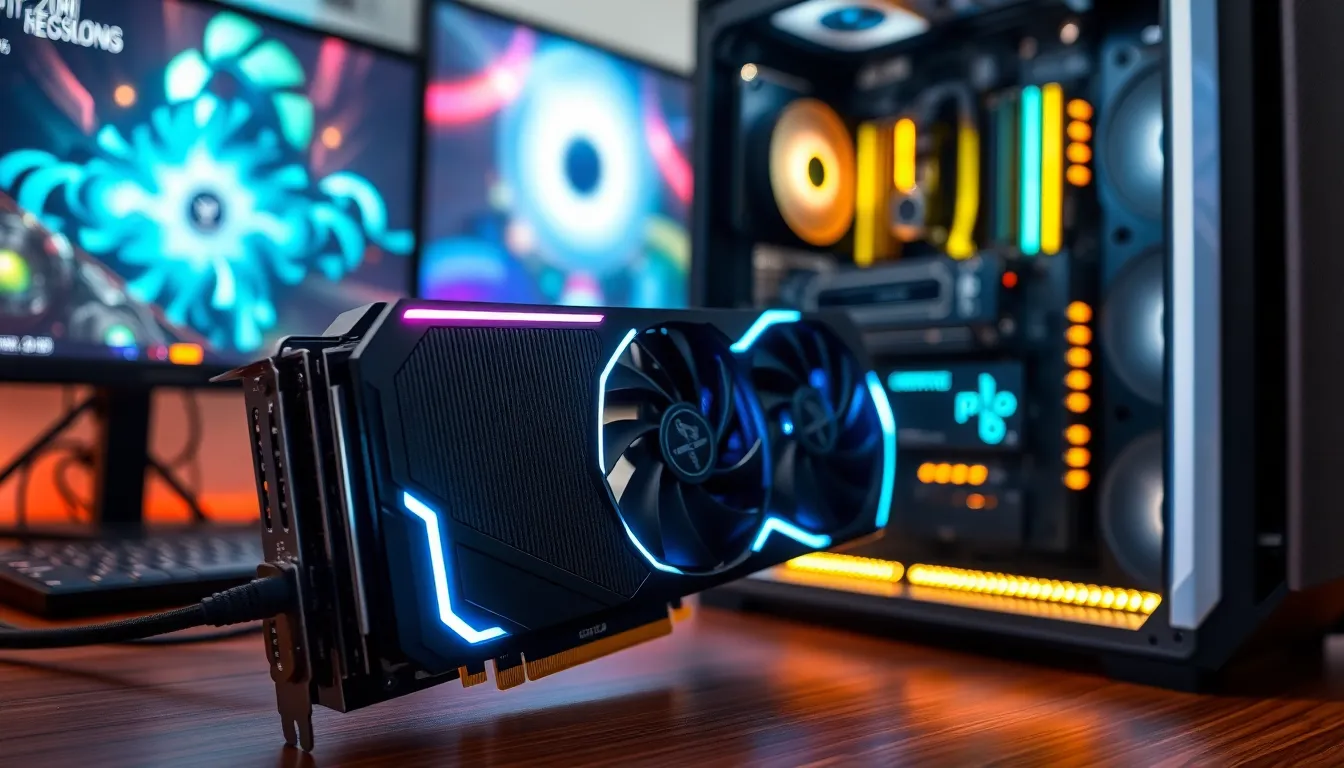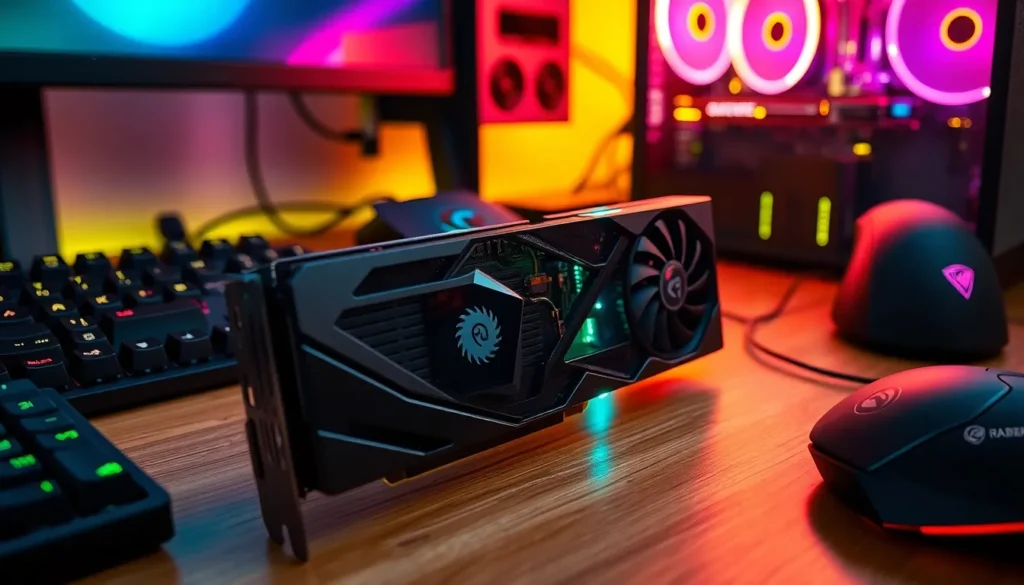In the fast-paced world of gaming and graphic design, choosing the right graphics card can make all the difference. With countless options flooding the market, it’s crucial to understand the key differences between each model. A well-chosen graphics card not only enhances performance but also ensures an immersive experience, whether it’s for gaming, video editing, or 3D rendering.
This guide dives into a comprehensive graphics card comparison, highlighting the strengths and weaknesses of popular models. By breaking down specifications, performance metrics, and price points, it equips readers with the knowledge needed to make informed decisions. Whether you’re a casual gamer or a professional creator, finding the perfect graphics card tailored to your needs is just a few paragraphs away.
Table of Contents
ToggleOverview of Graphics Cards
Graphics cards, also known as GPUs, play a crucial role in rendering images and videos. Several types exist, including integrated and dedicated options. Integrated graphics are built into the CPU and provide basic performance suitable for everyday tasks. Dedicated graphics cards offer higher performance, essential for gaming and professional applications.
Key specifications to consider include VRAM, clock speed, and architecture. VRAM, or video RAM, influences how much graphical data the card can handle. Cards with 4GB to 16GB are common in mid-range to high-end models. Clock speed, measured in MHz or GHz, affects processing speed. A higher clock speed typically results in better performance. Finally, architecture governs the card’s efficiency and capability, with newer architectures often offering enhanced features and performance improvements.
Popular brands include NVIDIA and AMD, each offering various models tailored to different user needs. NVIDIA’s RTX series features real-time ray tracing, providing stunning visuals. AMD’s Radeon RX series focuses on competitive pricing and solid gaming performance. Both brands receive frequent updates to drivers, improving performance and compatibility.
In gaming, frame rate and resolution are crucial metrics. Most graphics cards target 60 frames per second at 1080p resolution for a smooth experience. Higher resolutions, such as 4K, require more powerful GPUs to maintain playable frame rates. Graphics settings, such as texture quality and shadows, also influence performance and visual fidelity.
Investing in a graphics card involves balancing budget with performance requirements. Understanding personal needs can lead to selecting the optimal model, whether for gaming, graphic design, or professional rendering.
Key Factors in Graphics Card Comparison

Choosing the right graphics card involves evaluating several important factors. These factors contribute significantly to the overall performance and efficiency of the graphics card.
Performance Metrics
Performance metrics serve as key indicators of a graphics card’s capabilities. Essential metrics include:
- Frame Rate: Higher frame rates deliver smoother visuals. Most modern GPUs target at least 60 frames per second at 1080p resolution.
- VRAM: Video RAM is crucial for handling textures and complex graphics. Cards with 6GB or more VRAM perform better in demanding applications.
- Clock Speed: Measured in megahertz (MHz), higher clock speeds can enhance processing power and overall performance.
- Architecture: The card’s architecture influences efficiency and performance. Newer architectures often support advanced features like ray tracing.
Price-to-Performance Ratio
Price-to-performance ratio helps evaluate the value of a graphics card. It’s calculated by dividing the card’s price by its performance metrics. Considerations include:
- Cost: Cards priced under $300 often cater to casual gamers, while those over $600 focus on professional needs and high-end gaming.
- Performance Benchmarks: Comparing benchmark scores from credible sources, such as 3DMark or user reviews, allows for accurate assessments of performance against price.
- Upgradability: Investing in a slightly more expensive card might yield better longevity and future-proofing, making it a wise financial decision in the long run.
Power Consumption
- TDP (Thermal Design Power): This rating, indicated in watts, represents the maximum heat output and energy consumption under load. Cards with a TDP under 200 watts are typically more efficient.
- Power Supply Requirements: Higher wattage cards require robust power supplies, potentially increasing overall costs.
- Efficiency Ratings: Cards with better power efficiency consume less energy while delivering optimal performance, impacting both utility bills and environmental concerns.
Popular Graphics Cards in 2023
Graphics cards from leading brands dominate the market in 2023, each offering unique features and performance levels. Both NVIDIA and AMD provide a range of models catering to different user needs, from casual gaming to professional creative work.
Nvidia Models
NVIDIA’s graphics cards, particularly the GeForce RTX 3000 and 4000 series, remain popular due to their advanced technology.
- GeForce RTX 4090: The flagship model features 24 GB of GDDR6X VRAM, delivering exceptional performance for 4K gaming and creative applications. It supports real-time ray tracing and AI-driven features, making it suitable for demanding tasks.
- GeForce RTX 4080: With 16 GB of GDDR6X VRAM, this model offers strong performance in high-resolution settings while being more affordable than the RTX 4090. It balances power and price, targeting gamers seeking top-tier performance without breaking the bank.
- GeForce RTX 4070 Ti: This option features 12 GB of GDDR6X VRAM, providing excellent frame rates at 1440p resolution. It’s designed for gamers looking for high-quality graphics at a more accessible price point.
AMD Models
AMD’s Radeon RX series also presents noteworthy alternatives for various user scenarios.
- Radeon RX 7900 XTX: This model showcases 24 GB of GDDR6 VRAM, emphasizing performance against competitors in 4K gaming. It offers a competitive price-to-performance ratio, appealing to gamers wanting high-quality graphics without premium costs.
- Radeon RX 7900 XT: Featuring 20 GB of GDDR6 VRAM, this card delivers solid performance at 1440p, making it suitable for mid-range gaming. It strikes a balance between performance and affordability.
- Radeon RX 6700 XT: Equipped with 12 GB of GDDR6 VRAM, this model targets gamers focused on 1080p and 1440p resolutions. Its competitive pricing makes it a strong contender in its segment, providing great value for the performance offered.
Graphics Card Use Cases
Graphics cards serve distinct purposes, primarily in gaming and creative workloads. Selecting the appropriate GPU enhances performance and user experience, tailoring it to specific tasks.
Gaming Performance
Gaming performance hinges on several key factors. Frame rates, resolution, and graphical fidelity determine the overall experience. Most gamers target 60 frames per second (FPS) at 1080p resolution. For more demanding titles, higher resolutions often require GPUs with greater power. Specific models, such as the NVIDIA GeForce RTX series, support advanced features like ray tracing and DLSS, which further enhance visuals. AMD’s Radeon RX series provides competitive performance at various price points, ensuring quality experiences across different gaming platforms.
Creative Workloads
Creative workloads encompass tasks such as video editing, 3D rendering, and graphic design. These applications benefit from dedicated GPUs that efficiently handle large data sets and complex rendering tasks. For instance, NVIDIA’s RTX series excels in software that utilizes CUDA cores, speeding up rendering and processing times. In contrast, AMD’s Radeon RX series provides affordability alongside solid performance for creatives. High VRAM capacity is crucial for managing high-resolution assets, and both NVIDIA and AMD offer models catering to graphic designers and video editors seeking optimal performance within their budget constraints.
Choosing the right graphics card is crucial for optimizing gaming and creative experiences. By understanding key specifications and performance metrics, users can make informed decisions that align with their specific needs. The market offers a variety of options from leading brands like NVIDIA and AMD, each catering to different performance levels and budgets.
Whether seeking high frame rates for gaming or efficient rendering for creative tasks, there’s a suitable graphics card available. Staying updated on the latest models and technologies ensures users can maximize their investment, enhancing both performance and enjoyment in their digital endeavors.





